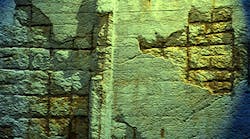New Method of Detecting Corroding Concrete Could Pinpoint Crumbling Infrastructure
Researchers at the National Institute of Standards and Technology (NIST) are using a novel form of x-rays to detect corrosion, the primary danger threatening the health of the steel framework within the nation’s bridges, roads, and other aging physical infrastructure. This noninvasive “spectral fingerprint” technique reveals the corrosion of concrete-encased steel before it can cause any significant degradation of the structure it supports. This could help in defining the Trump administration’s proposed $1 trillion project to rebuild and maintain U.S. infrastructure.
When iron corrodes, it produces different iron oxide products, with the two most common being goethite and hematite. “The brown rust that forms when you leave a hammer out in the rain is mostly goethite, and when a steel reinforcing bar or rebar corrodes inside a concrete bridge deck, that is mostly hematite,” said NIST physical chemist Dave Plusquellic.
“We have shown that terahertz radiation—electromagnetic waves with frequencies 10 to 100 times higher than microwaves used to cook food—detects both corrosion products in the early stages of formation.”
Current imaging methods for uncovering corrosion use microwaves to record changes in the physical state of the affected steel, such as changes in the thickness of rebar inside a bridge or other structures’ concrete. “Unfortunately, by the time these changes can be detected, the corrosion is already well on its way toward causing cracks in the concrete,” said physicist and NIST Fellow Ed Garboczi.
Additionally, Garboczi noted that most microwave imaging methods rely on comparisons with baseline measurements of the steel taken during of construction, a practice that only goes back about 25 years. “That’s a real problem,” he explained, “since the average age of the 400,000 steel-reinforced concrete bridges in the U.S. is 50 years, and there is no baseline data available for many of them.”
The NIST terahertz wave detection method works because goethite and hematite are antiferromagnetic. In other words, the pairs of electrons sitting side-by-side within iron atoms in these materials spin in opposite directions, leaving them unaffected by external magnetic fields. In contrast, electrons in iron atoms of a refrigerator magnet (which is ferromagnetic) spin in the same direction, and are either attracted or repelled by external magnetic fields.
“Terahertz waves flip the spin alignment of one electron in a pair, and are absorbed by hematite or goethite,” Plusquellic said. While using a millimeter wave detector, the researchers discovered that this antiferromagnetic absorption only occurs within narrow frequency ranges in the terahertz region of the electromagnetic spectrum. This creates “spectral fingerprints” unique to goethite and hematite—and in turn, iron corrosion.
With current advances in terahertz sources and detectors, the new NIST nondestructive technique could quickly detect small amounts of iron-bearing oxides, the sign of early-stage corrosion in steel surrounded by concrete, polymer composites (such as pipe insulation in a factory), paints, and other protective materials.
“In the lab, we have demonstrated that a 2-milliwatt terahertz source generates waves that detect hematite through 25 millimeters of concrete,” Plusquellic said. “Using terahertz sources with powers in the hundreds of milliwatts and state-of-the-art receivers with unprecedented signal-to-noise ratios, we should be able to penetrate 50 millimeters, which is how thick the concrete is covering the first layer of rebar in most steel-reinforced concrete structures.”
The NIST team will now look for a spectral fingerprint for akageneite, an iron corrosion product formed in the presence of chloride ions, which comes from sources such as seawater and road deicing salt. “Akageneite can cause problems in steel-reinforced concrete similar to those seen with goethite and hematite,” Garboczi said.
New Method of Detecting Corroding Concrete Could Pinpoint Crumbling Infrastructure was originally published on MachineDesign, an Endeavor Business Media partner site.










